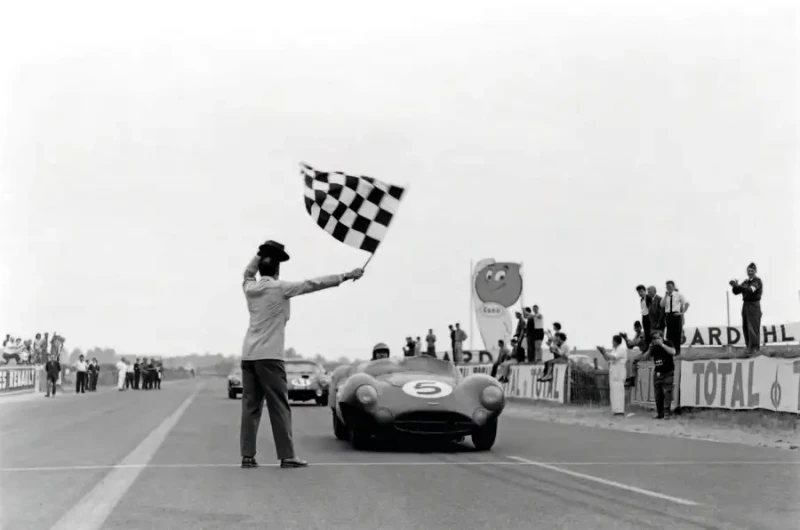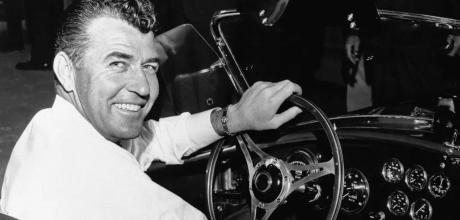Aston Martin drivers - Carrol Shelby
To mark the 100th anniversary of Carroll Shelby’s birth, we look at the career of this iconic American who won the 1959 Le Mans
Carroll Shelby’s victory at the 1959 Le Mans 24 Hours for Aston Martin firmly cemented the American’s place in the history of European racing. Yet this was only one highlight in a highly illustrious career that saw success on both sides of the Atlantic and the cockpit. Born in Leesburg, Texas, on 11 January 1923, Shelby’s interest in cars began at a young age, learning how to drive in a Willys. “I raced everybody who wanted to race,” he said years later.

Following graduation from high school in 1942, Shelby enlisted in the Army Air Corps that saw him take to the skies in B-17 Flying Fortresses and many other heavy bombers throughout the second world war. After leaving the army, he started his own truck business before becoming an oil worker and then a poultry farmer. It was all of his chickens dying in 1952 that pushed him towards racing. “I’d always wanted to be a racing driver,” he said during a 1991 interview. “I was 29 years old and I said, ‘To hell with it, I’m going out to do that.’”
He originally used a friend’s MG TC before moving to a much faster Cadillac-powered Allard J2X. It was by finishing tenth in the 1954 Buenos Aires 1,000km race in January that resulted in an invitation by Aston Martin’s team manager, John Wyer, to drive a DBR3S at Sebring two months later. Although retiring due to a broken rear axle, Shelby continued with the British team in Europe throughout the year. Shelby stayed largely in America for the next three seasons. Extremely fast and always consistent, he enjoyed great success, winning three national driver’s championships in that time.
He returned to Europe for 1958 to again drive for Aston Martin. With the DBR1 underpowered and often fragile, results were thin on the ground with a second at that year’s Tourist Trophy being a highlight. With Aston concentrating on its burgeoning Formula One eff ort for 1959, Shelby raced the DBR/4 single seater four times but with little success.
Yet the company still entered three DBR/1s into the Le Mans 24 Hours when Shelby was teamed with Aston regular, Roy Salvadori. Despite running fifth at the start, retirements meant the pair took the lead on the Saturday evening, which they held on to into the night. Damage to the nearside rear tyre caused a vibration which took a ten-minute pit stop at 2am to diagnose, handing the lead to the Ferrari 250 of Phil Hill and Olivier Gendebien. But the Italian car retired a few hours later, giving victory to Shelby and Salvadori.
“It felt wonderful,” said the American years later. “Aston never quite had the horsepower and so Ferrari was always quicker down the straights but we probably had better preparation than Ferrari at the time. That was the high point of my life as far as driving racing cars.” Despite arguably being at the height of his career, Shelby retired at the end of the following year after being diagnosed with heart condition which he took nitroglycerine for.
Shelby would become arguably more famous as a constructor than as a driver especially after he fitted a Ford V8 to the diminutive AC Ace sports car in 1964, creating the famous Cobra. The car was raced with great success especially with a more aerodynamic body. Named the Daytona, after the circuit where it first raced, the car finished first in the GT class and fourth overall at the 1964 24 Hours of Le Mans. On the strength of this, Ford later asked him to turn the disappointing GT40 into race winner and in 1966 it won Daytona, Sebring and Le Mans.
Starting with the GT350-based Ford Mustang in 1965, Shelby became even more associated with higher performance versions of production cars, later doing the same with Dodge, Chrysler and Oldsmobile. His name is once again with Ford, since Shelby American is modifying the current generation of Mustang.
Shelby died on May 10 2012, at the age of 89. Although perhaps better known today as a car manufacturer, he will also be remembered as a great driver and part of Aston’s sole Le Mans victory.


